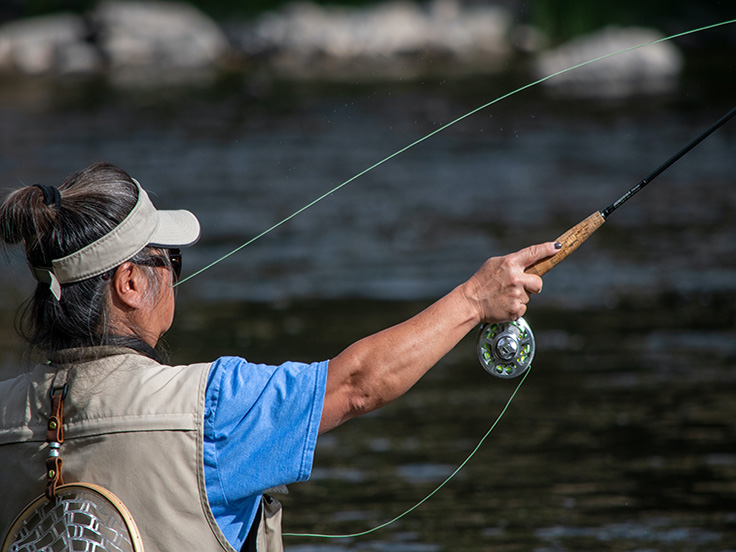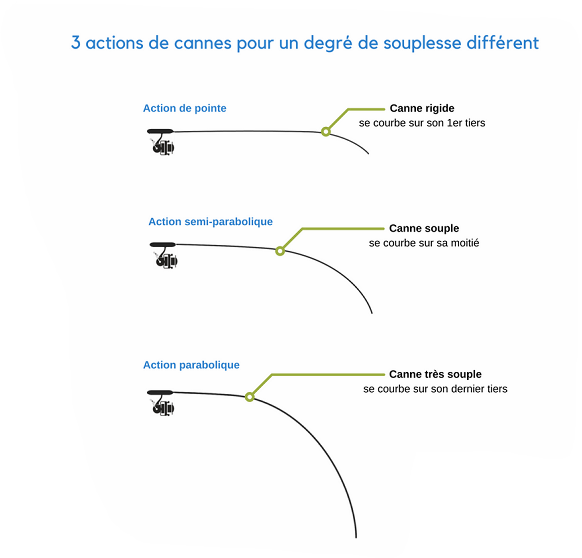
The fly fishing is an ancestral technique that has been democratized since the 20th century. It is most often practiced in a river using very specific equipment that you can easily find in our Fly fishing collection :
- A rod fishing very light that is measured in feet
- A reel simple at first glance that plays the role of reserve of thread, equipped with a brake
- Lines called silks
- Lures such as a nymph (aquatic larva), a streamer (imitation of a small fish) or a dry fly (imitation of a flying insect); with a size and one function unique to each one
Becoming increasingly popular thanks to guides and videos on the internet that make it easy to acquire the know-how to get started in this type of fishing, which requires relatively significant knowledge. However, nothing will replace practice, adapting to wind or fish at the surface of a reservoir is only understood during a real session.
We instantly think of a fisherman stalking a trout river, but it should be known that it is possible to catch a much larger fish such as a pike or even in salt water, the bass.
Whether you are fisherman beginner or advanced, becoming fly fishers is not easy, what action, what length and what power in function Which technique will I use? Many questions are running through your head and we are here to shed light on some of them.
What action for your rod to fly?
Let's start then with the action that you will choose for your future rods. We can define "action" as the ability of the rod flyswatter To bend under the pressure of a pull. There are then several, an action called tip, a parabolic action and a semi-parabolic action.
The leading action
This action means that the rod is very rigid, during your throws or a fight, you would notice that only the tip will bend under pressure.
You probably suspect that there are advantages, but also disadvantages. Your throws will be made with great precision, but in return, the chances of disengagement are much higher. It is necessary during fights to keep your wrist flexible so as not to break.
The parabolic action
This time, it's the complete opposite, it's a rod fishing fish is increased. Very flexible, even some would say soft. As a result, your casts are less accurate, but your ability to fight bigger fish is increased. trout or pike with a silk will be much higher. Discover our article.Which silk to choose for fly fishing to understand the subtleties of such a choice.
The semi-parabolic action, the happy medium
We have presented you with the two "extremes", now here is what we could call the middle ground. We take a bit of both, and we get a rod which bends moderately under pressure and offers more precision to throws. A very versatile action, ideal for beginners who are fumbling to discover which action suits them best.
There is no good or bad action, in reality it's up to the feelings of the fly fishers that are dormant within you. What is essential is to choose in accordance with the technique you will use, the species you will track, and the spots where you will go fishing., reservoir, sea, torrent... Don't forget to also adapt your reel and the silks that you would use, it can never be said enough!
What is the ideal length for a rod fly ?
Now that you have a more or less developed idea about the action that will suit you best, you need to choose the length. feet or in inches, of your future whip.
For the laziest among us (including myself), there are converters that do the work for us.


Choose your length rod It is like this fishing, meticulous, indeed, you will have to take into account some factors. The width of the bodies of water in which you wish to fish, the type of technique that interests you, and the riparian vegetation (vegetation specific to the middle of rivers and banks).
For dry fly fishing
If you are looking for shadows and/or trouts, it will be easier for you to choose, as this is the least demanding category that will most easily accept any type of length. What will guide your choice is rather the configuration of the environment, small and large bodies of water, calm or agitated.
Two teams face off, the fans of short 6' to 7' models for streams, offering maximum maneuverability, and the fans of long 9' to 11' models (especially in France) which allow a minimum of casts.
In long model, G Loomis gives us the pleasure of offering an extremely reliable and versatile model that will perform just as well dry as with nymphs. The Rod to Fly G Loomis NRX+ 10' would therefore be a preferred choice !
The solution we can suggest is to start with a standard length varying between 8.6' and 9' and then decide to switch sides by analyzing your feelings.
For wet fly fishing
This time it's simple and effective, the experts are clear, no less than 9'. You will need such a size to guide your bait in the wind to the surface of the water. You will need to slow down, speed up while repositioning your line, such a size will be your best ally.
We advise you to prefer a parabolic action, in order to avoid breakage due to many failures. A model could be quite suitable, we are thinking of the Rod to Fly Marryat Tactical. A series of rod capable of performing all practices in France and this, with great ease. A series recognized by all the great fly fishermen.
For nymph fishing
If you wish to practice the so-called "sight" technique, you will need to be quick while handling a line that is 6 or 7 meters long. The appropriate solution is a length ranging from 8 to 9 feet, very classic indeed, but this will allow you to achieve the necessary versatility.
In the case of a "on the go" practice, it is necessary to hold the rod in a high position, sometimes for several hours. Professionals therefore recommend a significant length in order to minimize muscle fatigue, 9.6' to 10' is a wise choice.
If we were to recommend only one thing to you rod, it would be the Rod Fly Marryat Tactical Pro 3 Nymph Special. A rod specially designed for this fishing, which will work wonders in all situations.
For predator fishing with streamer
Your rod should be powerful enough to propel lures up to 20cm, a semi-parabolic or even parabolic action should be considered. A length of 9' to 9.6' is most suitable for this kind of situation.
Marryat thought of you, by proposing a rod perfect for this kind of need, we are talking about the Rod to Fly Marryat Tactical Pikky 9', a condensed know-how to track down predators, especially the pike !
What power for your rod ?
.png)
We now arrive at the last piece of the puzzle, the choice of power, it is not symbolized by grams as is the case in traditional lure fishing. Here, it is a matter of a number. silk, it corresponds to the capacity of the rod to cast a more or less heavy silk effectively and without fatigue.
The weakest rods have a power of #3 and #4, ideal for keeping you discreet when casting at short distances. Streams, clear waters, etc. are all places suitable for this kind of power, which is known to be very challenging. You will most of the time be tracking wild trout.
The #4 and #5 powers are very versatile, ideal for dealing with many situations. You can practice almost all techniques.
Powers greater than #6 will be used by experienced fishermen or those who fish in areas such as torrents, to track predators or sea bass.
All that's left for you to do is take the plunge and treat yourself to your new jewel! Practicality, rigor, and knowledge will be necessary, but once mastered, you will quickly become addicted... We recommend a rod In 8.6' to 9' in semi-parabolic action to learn and be able to touch on all techniques.
Our other articles about fly fishing:
